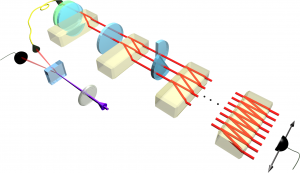Making light matter
- Post by: admin
- September 4, 2012
- No Comment

We have a new paper in Nature Communications, Observation of topologically protected bound states in photonic quantum walks. Here’s our press release which unfortunately didn’t quite make it into the official press channels because of a fundamental disconnect between what we researchers wanted to write and the official PR guidelines at UQ:
At first glance, a donut and a coffee cup do not have much in common, except that they complement each other really well.
A second glance reveals that they share a geometrical property, their topology: the shape of one can be continuously deformed into the shape of the other.
Topology explains many phenomena in modern science: transitions between physical regions with different topology cause exotic effects such as insulators which act like conducting metals at the surface.
These effects are hard to control and study since they usually appear in complex materials where quantum particles are hard to observe. Researchers at the University of Queensland and Harvard University have simulated transitions between quantum topologies—predicted to exist, but never observed, in polymers and high-energy physics—in an experiment where light is made to act like matter.
“We observed for the first-time bound states—where a quantum particle is trapped at a topological interface—which have long been predicted to play an important role”, says Matthew Broome, joint lead author of this work and PhD student at the University of Queensland, “It was easy to observe these trapped photons, which is usually a challenging task in material sciences.”
The team at Harvard recently predicted that quantum walks can simulate systems with different topological regions. The experimentalists at Queensland persuaded single particles of light—photons—to walk through an optical network.
“Quantum walks have been previously realized in variety of settings with ions, atoms and photons, but nobody really knew that they could observe the exciting topological phenomena with quantum walks before our discovery”, says Takuya Kitagawa, joint lead author who developed the theory with his colleagues at Harvard, “This discovery came as a complete surprise to everybody, including us.”
Furthermore the versatile system invented by the UQ team allowed a surprising new discovery, the existence of a pair of bound states—a topological phenomenon which arises in dynamic time-dependent systems only.
This discovery bears exciting prospects for the development of novel materials and even powerful—but so far elusive—quantum computers.
The study, “Observation of topological bound states in photonic quantum walks”, by UQ’s Matthew Broome, Alessandro Fedrizzi, Ivan Kassal, and Andrew White, and Harvard’s Takuya Kitagawa, Erez Berg, Mark Rudner, Alán Aspuru-Guzik and Eugene Demler, was published in Nature Communications.
The experiment was conducted by researchers from the ARC Centre for Engineered Quantum Systems (EQuS) and the ARC Centre for Quantum Computation and Communication Technology (CQC2T) in Australia; and Harvard University, USA.